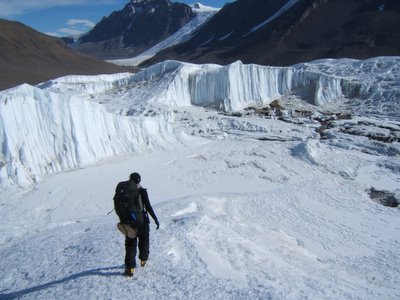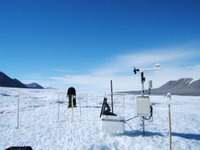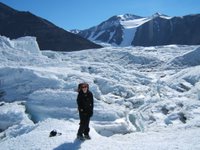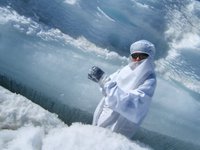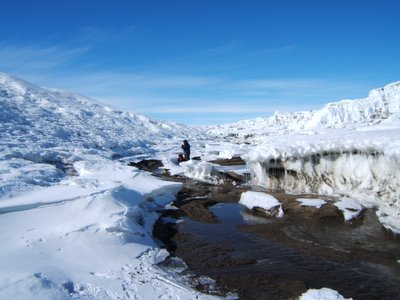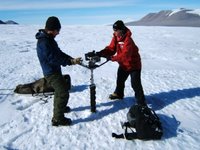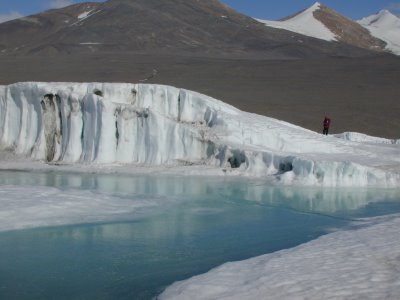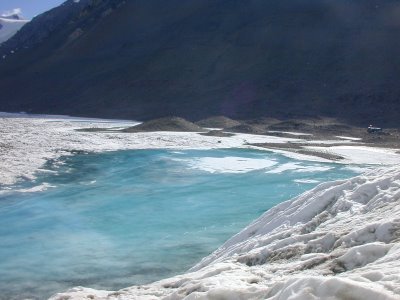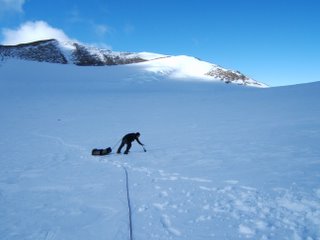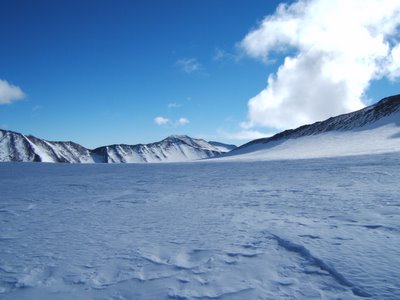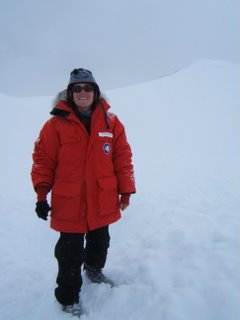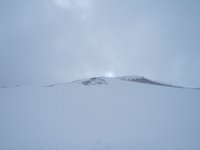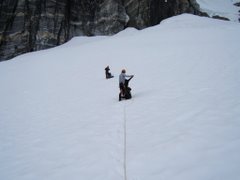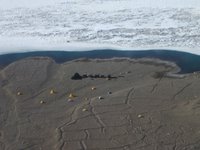 Today is my last full day in the Taylor Valley. Tomorrow I will be heading to the other side of the Canada Glacier (Lake Fryxell camp pictured), and then back to McMurdo Station. It is Sunday- shower day again! And the camp is quiet except for me and the metal sculpturist Gabriel, who are busy waking up to the computer and coffee. (He seeks to be one with the inner spaces of crevasses---although I'm not sure if he will actually be able to see one up close, as this is very technical). He is intense in every sense--- he just sneezed--- I said bless you and he said "it seems my metabolism is just waking up and demanding some oxygen" At any rate, although he hasn't visited crevasses per se, he has been able to explore the safer areas at the bottom of the Canada Glacier, and look and the unusual cliffs.
Today is my last full day in the Taylor Valley. Tomorrow I will be heading to the other side of the Canada Glacier (Lake Fryxell camp pictured), and then back to McMurdo Station. It is Sunday- shower day again! And the camp is quiet except for me and the metal sculpturist Gabriel, who are busy waking up to the computer and coffee. (He seeks to be one with the inner spaces of crevasses---although I'm not sure if he will actually be able to see one up close, as this is very technical). He is intense in every sense--- he just sneezed--- I said bless you and he said "it seems my metabolism is just waking up and demanding some oxygen" At any rate, although he hasn't visited crevasses per se, he has been able to explore the safer areas at the bottom of the Canada Glacier, and look and the unusual cliffs.
I wish him well, but, I will definitely go on a solo hike today (with a radio and a location written on the check out board). He will most likely head with Liz and Hassan to the Suess Glacier where they will measure the mass loss on ablation stakes. It is important that I take my thoughts with me from the valley- I fear that if I go hiking with too much talk, the magic will sublimate too quickly.
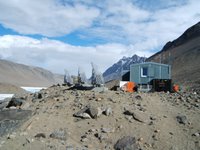 This morning drinking strong coffee, it is much like home. Although, here we sort our garbage into various bags, lab waste, burnables, food waste, light metal, construction waste, cardboard, glass, and as we hike we collect our pee in bottles as to not alter the ecosystem. Other human waste is ignited in the rocket toilets, that Rae and Heidi must diligently flame- to reduce into ashes, making a lighter sling-load for the helicopter pilots. Every trace of us is carried off the continent, making this trip expensive--- and the fuel costs enormous. That is the difficult part. Trying to understand the effects of the industrialized world on remote places, while burning more fuel than I would biking to and from school at home. We must do our best. At Lake Hoare Camp, we use solar panels for all of our energy (much more environmentally friendly than fossil fuel burning at McMurdo Station).
This morning drinking strong coffee, it is much like home. Although, here we sort our garbage into various bags, lab waste, burnables, food waste, light metal, construction waste, cardboard, glass, and as we hike we collect our pee in bottles as to not alter the ecosystem. Other human waste is ignited in the rocket toilets, that Rae and Heidi must diligently flame- to reduce into ashes, making a lighter sling-load for the helicopter pilots. Every trace of us is carried off the continent, making this trip expensive--- and the fuel costs enormous. That is the difficult part. Trying to understand the effects of the industrialized world on remote places, while burning more fuel than I would biking to and from school at home. We must do our best. At Lake Hoare Camp, we use solar panels for all of our energy (much more environmentally friendly than fossil fuel burning at McMurdo Station).
Yesterday, Heidi and I sampled the top western ablation area on the Canada Glacie
 r- I tried to take a clean sample from a cryoconite hole- and it took much effort to find a good sampling location, as many of the holes were beginning to shut down and freeze through. The helicopter flew overhead once, and we laughed, imagining we were in glacier camo--- as the still white suits against the white glacier must make us nearly invisible from overhead. I filtered the last of my filterable samples (I will filter the metals at home, the lab isn't clean enough here.)
r- I tried to take a clean sample from a cryoconite hole- and it took much effort to find a good sampling location, as many of the holes were beginning to shut down and freeze through. The helicopter flew overhead once, and we laughed, imagining we were in glacier camo--- as the still white suits against the white glacier must make us nearly invisible from overhead. I filtered the last of my filterable samples (I will filter the metals at home, the lab isn't clean enough here.)Before we spent the afternoon on ice, we had a visit from the Science branch of the House Appropriations Committee- that is in charge of determining how US government funding for research is divided. Also on that flight was Patrick Leahy the Director of the USGS. He was on the committee that put together NAWQA (the National Water Quality Asssessment Program). I worked as an undergrad for the Wisconsin NAWQA Program--- He saw o
 ur field lab, and laughed when I mentioned it was similar to the NAWQA Bread Truck (A huge lab on wheels, that allows samples to be safely stored from site to site). Patrick Leahy was also excited to hear about the LTER (Long Term Ecological Research) that we were working on because he favors getting to know a site well. The LTER is much like NAWQA with a focus on collecting long term data sets. We both got pictures on our cameras to show our friends at the USGS (he lent me his hat--- must be the day before shower day:)
ur field lab, and laughed when I mentioned it was similar to the NAWQA Bread Truck (A huge lab on wheels, that allows samples to be safely stored from site to site). Patrick Leahy was also excited to hear about the LTER (Long Term Ecological Research) that we were working on because he favors getting to know a site well. The LTER is much like NAWQA with a focus on collecting long term data sets. We both got pictures on our cameras to show our friends at the USGS (he lent me his hat--- must be the day before shower day:) Hassan and I spoke about the stream gauges, met stations, ecosystems and geochemistry of the Taylor Valley to give the Committee and Patrick Leahy and overview of the MCM LTER. We all answered questions, and Rae showed them the facilities before they flew to Wright Valley to meet Dr. Diane McKnight and the stream team at the Onyx River Stream Gauge just north of us through the Asgard Range. I'm sure they had a beautiful flight.
Hassan and I spoke about the stream gauges, met stations, ecosystems and geochemistry of the Taylor Valley to give the Committee and Patrick Leahy and overview of the MCM LTER. We all answered questions, and Rae showed them the facilities before they flew to Wright Valley to meet Dr. Diane McKnight and the stream team at the Onyx River Stream Gauge just north of us through the Asgard Range. I'm sure they had a beautiful flight.It is ten now, so I am going to pack up and head for the hills. I must take these sights in--- It is now, when the science is done, that I feel the magnitude of the mountains surrounding me. The wide bowl that cups me, a mote in this everlasting- ever-changing valley.
